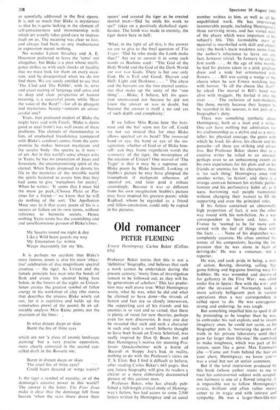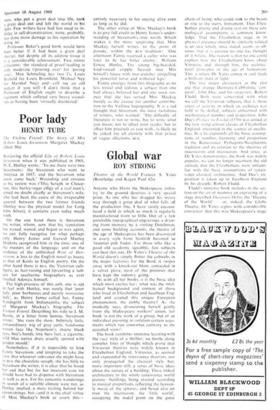Old romancer
PETER FLEMING
Ernest Hemingway Carlos Baker (Collins 63s)
Professor Baker insists that this is not a 'definitive' biography, and believes that such a work cannot be undertaken during the present century; 'many lines of investigation remain to be followed out, as they will be, by generations of scholars.' This last predic- tion may well prove true. What Hemingway wrote, what he was, what he did and what he claimed to have done—the strands of fiction and fact are so closely interwoven, the supporting cast of his friends and his enemies is so vast and so varied, that there is plenty of room for new theories, perhaps even for new discoveries. It may one day be revealed that such and such a character in such and such a novel, hitherto thought to have been based on Erwin Schnitzel, was really inspired by Dan Q. Boote Jnr. and that Hemingway's motive for stunning Pro- fessor Quackenheimer with a bottle of Bacardi in Sloppy Joe's had, in reality, nothing to do with the Professor's views on T. S. Eliot. But I find it difficult to believe, after reading Carlos Baker's 663 pages, that any future biography will give its readers a clearer or a more elaborately documented picture of this curious man.
Professor Baker, who has already pub- lished a full-length critical study of Heming- way's fiction, has had access to some 2,500 letters written by Hemingway and an equal number written to him, as well as all his unpublished work. He has interviewed innumerable people, including Hemingway's three surviving wives, and has visited most of the places which were important in his subject's life. This formidable mass of material is marshalled with skill and object- ivity; the book's main weakness stems from the author's reluctance to leave out any fact, however trivial. 'In January he cut his first tooth . . At the age of nine months he had his picture taken in a pink gingham dress and a wide hat ornamented with flowers. . . . Bill was eating a wedge of the cheese when he saw Ernest watching him with horror. "Is all the cheese like that?" he asked. The morsel in Bill's hand was alive with maggots. He hurled it into the river . .' The inclusion of non-incidents like these, merely because they happen to be recorded in his sources, is not part of a biographer's duty.
There was something synthetic about Hemingway, both as a man and a writer. One can have nothing but admiration for his craftsmanship as a stylist and as a story- teller; his physical courage, the gusto with which he lived, his drive, his charm and his panache—all these are striking and attrac- tive. But Professor Baker shows that as a creative writer he relied to an unusual. perhaps even to an unbecoming extent on his own experiences for his plots and on his friends or enemies for his characters; there is `no such thing,' Hemingway once told another writer, 'as fiction', and there is a strange contrast between his stylistic perfec- tionism and his perfunctory habit of, as it were, borrowing real people (sometimes without changing their names) to fill the supporting and even the principal roles.
If his fiction contained an abnormally high proportion of fact, it was the other way round with his non-fiction. As a war correspondent in Spain and, later, in France he 'seemed to be far more con- cerned with the feel of things than with the facts . . . None of his dispatches wt- completely accurate. He often omitted the names of his companions, leaving the im- pression that he was alone in feats of derring-do.' He was a romancer, not a reporter.
He was, and took pride in being, a man of action. Boxing, shooting, sailing, big- game fishing and big-game hunting were his hobbies. He was wounded and decorated for gallantry in the First War: was often under fire in Spain: flew with the a sF: and after the invasion of Normandy took a more actively belligerent part in various operations than a war correspondent is called upon to do. He was courageous, strong and enduring; he was tough.
But something impelled him to spoil it all by pretending to be tougher than he was, to embroider his real exploits and to invent imaginary ones; he could not resist, as his biographer puts it, 'nurturing the germs of truth in his private laboratory until they grew far larger than life-size.' He contrived to make toughness, which was part of his nature, seem like a pose; Max Eastman's jibe —'Come out from behind the hair on your chest, Hemingway; we know you'— was a cruel but not an unfair comment.
But if the total impression produced by this book (whose author seems to me to treat his controversial subject with scrupul- ous fairness) is one of a flawed integrity, it is impossible not to follow Hemingway's erratic, brilliant and often rather messy career to its tragic end with interest and sympathy. He was a larger-than-life-size man, who put a great deal into life, took a great deal out and left- the world in 'Ns debt. Few writers have had less need to in- dulge in self-dramatisation; none, probably, has done more damage to his reputation by doing so.
Professor Baker's good book would have been better if it had been a great deal shorter, but despite all its adipose tissue it is a considerable achievement. Two minor criticisms: the standard of proof-reading is only moderate (`pouring over' for 'poring over', Max Schmeling has two l's, Louis Brofield for Louis Bromfield, Michael Ney for Marshal Ney) and—call me an old pedant if you will—I don't think that a Professor of English ought to describe a regiment which suffered very-heavy casual- ties as having been `virtually decimated'.



































 Previous page
Previous page